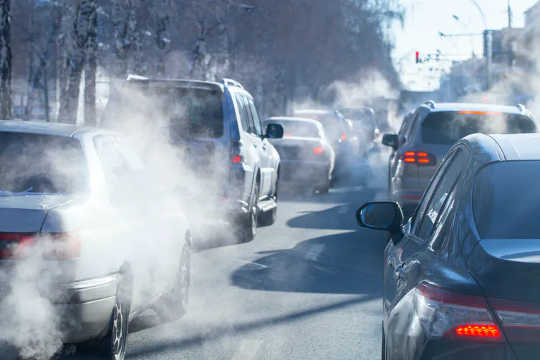
Shutterstock
Global emissions are expected to decline by about 7% in 2020 (or 2.4 billion tonnes of carbon dioxide) compared to 2019 — an unprecedented drop due to the slowdown in economic activity associated with the COVID-19 pandemic.
To put this into perspective, the Global Financial Crisis in 2008 saw a 1.5% drop in global emissions compared to 2007. This year’s emissions decline is more than four times larger.
These are the findings we show in the 15th global carbon budget, an annual report card of the Global Carbon Project on the sources and removals of carbon dioxide, the primary driver of human caused climate change.
It may sound like welcome news, but we can’t celebrate yet. A rapid bounce back of emissions to pre-COVID levels is likely, possibly by as soon as next year. A recent study found emissions in China snapped back to above last year’s levels during late spring when economic activity began to return to normal.
These findings come ahead of the Climate Ambition Summit on Saturday, where global leaders will demonstrate their commitments to climate action five years since the Paris Agreement. This huge drop in emissions should be taken as a unique opportunity to divert the historical course of emissions growth for good.
Emissions in the pandemic year
The total global fossil carbon dioxide emissions for 2020 are estimated to be 34 billion tonnes of carbon dioxide.
Estimated emissions at the beginning of December are lower than their levels in December last year, at least in the transport sectors. However, emissions have been edging back up since the peak global daily decline of 17% in early April.
The decline in emissions in 2020 was particularly steep in the United States (12%) and European Union (11%), where emissions were already declining before the pandemic, mainly from reductions in coal use.
Emissions from India dropped by 9%, while emissions from China, which have returned to close or above 2019 values, saw an estimated drop of only about 1.7%.
Australian greenhouse gas emissions during the peak of the pandemic lockdown (the quarter of March to June 2020) were lower by 6.2% compared to the previous quarter. The largest declines were seen in transport and fugitive emissions (emissions released during the extraction, processing and transport of fossil fuels).

The 2020 emission decline was particularly steep in the United States and European Union. While China’s emissions also dropped steeply, they snapped back later in the year. Pep Canadell, Author provided
Globally, the transport sector also contributed the most to the 2020 emissions drop, particularly “surface transport” (cars, vans and trucks). At the peak of the pandemic lockdowns, the usual levels of transport emissions were halved in many countries, such as in the US and Europe.
While aviation activity collapsed by 75%, its contribution to the total decline was relatively small given the sector only accounts for about 2.8% of the total emissions on an average year. The number of global flights was still down 45% as of the first week of December.
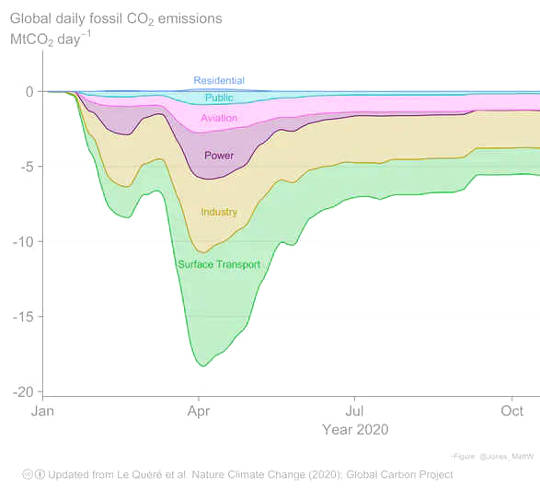
The industry sector, specifically metals production, chemicals and manufacturing, was the second largest contributor in emissions declines. Pep Canadell, Author provided
Global emissions were already slowing down pre-COVID
Overall, global emissions have increased by 61% since 1990. But the pace of this growth has varied.
In the early 1990s, the growth in emissions slowed down due to the collapse of the former Soviet Union, but then increased very quickly during the 2000s, by 3% per year on average. This was, in part, due to the rise of China as an economic power.
Over the last decade, however, the pace of emissions began to slow again, with an increase just below 1% per year. And emissions in 2019 didn’t grow much, if at all, when compared to 2018.
Behind the global slowing trend, there are 24 countries that had carbon dioxide fossil emissions declining for at least one decade while their economy continued to grow. They include many European countries such as the Denmark, the UK and Spain, and the USA, Mexico and Japan. For the rest of the world, emissions continued to grow until 2019.
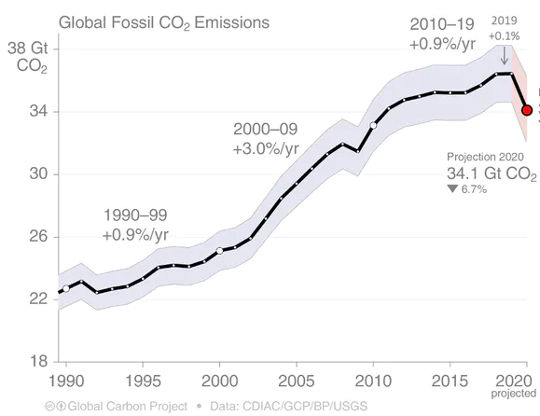
This chart shows how global fossil carbon dioxide emissions have increased since the 1990s. Note the drops in the early 1990s, in 2008, and the huge drop in 2020. Pep Canadell, Author provided
An opportunity to boost ambition
The pandemic, along with other recent trends such as the shift towards clean energy, have placed us at a crossroad: the choices we make today can change the course of global emissions.
In addition to the slow down in global emissions in recent years, and this year’s drop, there are now dozens of countries that have pledged to reach net zero emissions by mid century or soon after.
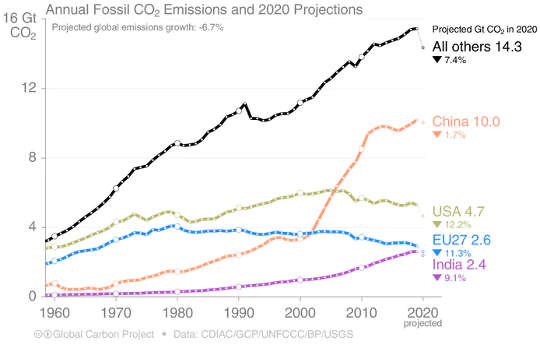
How the emissions of different countries have changed over time.
Importantly, the first (China), second (USA), third (European Union), sixth (Japan) and ninth (South Korea) top emitters — together responsible for over 60% of the global fossil carbon dioxide emissions — have either legally binding pledges or serious ambitions to reach net zero emissions by 2050 or soon after.
Coal production, the largest fossil fuel source of carbon dioxide emissions, peaked in 2013. Its decline continues to this date; however, increasing natural gas and oil negate much of this decline in emissions.
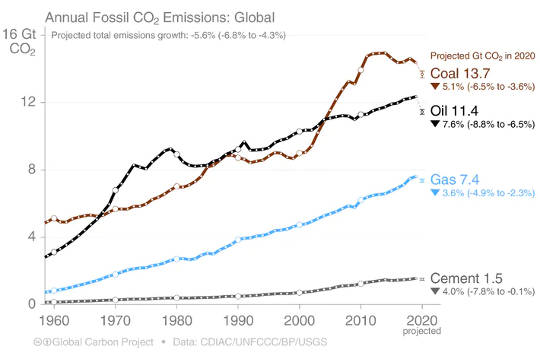
How the emissions from coal, oil, gas, and cement sectors changed over time. Pep Canadell, Author provided
We are in the midst of extraordinary levels of economic investment in response to the pandemic. If economic investment is appropriately directed, it could enable the rapid expansion of technologies and services to put us on track towards net zero emissions.
Many countries have already committed to green recovery plans, such as South Korea and the EU, although investments continue to be dominated by the support of fossil-based infrastructure.
As global leaders prepare for tomorrow’s summit, they have an opportunity like never before. The choices we make now can have a disproportionate impact on the future trajectory of emissions, and keep temperature rise well and truly below 2?.
 About the Authors
About the Authors
Pep Canadell, Chief research scientist, Climate Science Centre, CSIRO Oceans and Atmosphere; and Executive Director, Global Carbon Project, CSIRO; Corinne Le Quéré, Royal Society Research Professor, University of East Anglia; Glen Peters, Research Director, Center for International Climate and Environment Research - Oslo; Matthew William Jones, Senior Research Associate, University of East Anglia; Philippe Ciais, Directeur de recherche au Laboratoire des science du climat et de l’environnement, Institut Pierre-Simon Laplace, Commissariat à l’énergie atomique et aux énergies alternatives (CEA); Pierre Friedlingstein, Chair, Mathematical Modelling of Climate, University of Exeter; Robbie Andrew, Senior Researcher, Center for International Climate and Environment Research - Oslo, and Rob Jackson, Professor, Department of Earth System Science, and Chair of the Global Carbon Project, Stanford University
This article is republished from The Conversation under a Creative Commons license. Read the original article.
Related Books
Life After Carbon: The Next Global Transformation of Cities
by Peter Plastrik , John Cleveland The future of our cities is not what it used to be. The modern-city model that took hold globally in the twentieth century has outlived its usefulness. It cannot solve the problems it helped to create—especially global warming. Fortunately, a new model for urban development is emerging in cities to aggressively tackle the realities of climate change. It transforms the way cities design and use physical space, generate economic wealth, consume and dispose of resources, exploit and sustain the natural ecosystems, and prepare for the future. Available On Amazon
The future of our cities is not what it used to be. The modern-city model that took hold globally in the twentieth century has outlived its usefulness. It cannot solve the problems it helped to create—especially global warming. Fortunately, a new model for urban development is emerging in cities to aggressively tackle the realities of climate change. It transforms the way cities design and use physical space, generate economic wealth, consume and dispose of resources, exploit and sustain the natural ecosystems, and prepare for the future. Available On Amazon
The Sixth Extinction: An Unnatural History
by Elizabeth Kolbert Over the last half-billion years, there have been Five mass extinctions, when the diversity of life on earth suddenly and dramatically contracted. Scientists around the world are currently monitoring the sixth extinction, predicted to be the most devastating extinction event since the asteroid impact that wiped out the dinosaurs. This time around, the cataclysm is us. In prose that is at once frank, entertaining, and deeply informed, New Yorker writer Elizabeth Kolbert tells us why and how human beings have altered life on the planet in a way no species has before. Interweaving research in half a dozen disciplines, descriptions of the fascinating species that have already been lost, and the history of extinction as a concept, Kolbert provides a moving and comprehensive account of the disappearances occurring before our very eyes. She shows that the sixth extinction is likely to be mankind's most lasting legacy, compelling us to rethink the fundamental question of what it means to be human. Available On Amazon
Over the last half-billion years, there have been Five mass extinctions, when the diversity of life on earth suddenly and dramatically contracted. Scientists around the world are currently monitoring the sixth extinction, predicted to be the most devastating extinction event since the asteroid impact that wiped out the dinosaurs. This time around, the cataclysm is us. In prose that is at once frank, entertaining, and deeply informed, New Yorker writer Elizabeth Kolbert tells us why and how human beings have altered life on the planet in a way no species has before. Interweaving research in half a dozen disciplines, descriptions of the fascinating species that have already been lost, and the history of extinction as a concept, Kolbert provides a moving and comprehensive account of the disappearances occurring before our very eyes. She shows that the sixth extinction is likely to be mankind's most lasting legacy, compelling us to rethink the fundamental question of what it means to be human. Available On Amazon
Climate Wars: The Fight for Survival as the World Overheats
by Gwynne Dyer Waves of climate refugees. Dozens of failed states. All-out war. From one of the world’s great geopolitical analysts comes a terrifying glimpse of the strategic realities of the near future, when climate change drives the world’s powers towards the cut-throat politics of survival. Prescient and unflinching, Climate Wars will be one of the most important books of the coming years. Read it and find out what we’re heading for. Available On Amazon
Waves of climate refugees. Dozens of failed states. All-out war. From one of the world’s great geopolitical analysts comes a terrifying glimpse of the strategic realities of the near future, when climate change drives the world’s powers towards the cut-throat politics of survival. Prescient and unflinching, Climate Wars will be one of the most important books of the coming years. Read it and find out what we’re heading for. Available On Amazon
From The Publisher:
Purchases on Amazon go to defray the cost of bringing you InnerSelf.comelf.com, MightyNatural.com, and ClimateImpactNews.com at no cost and without advertisers that track your browsing habits. Even if you click on a link but don't buy these selected products, anything else you buy in that same visit on Amazon pays us a small commission. There is no additional cost to you, so please contribute to the effort. You can also use this link to use to Amazon at any time so you can help support our efforts.






















